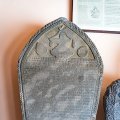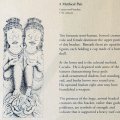Patan Museum (Nepal): photo 11
Photo 11 of 212 in Gallery: Patan Museum (Nepal)

Image title: Temple Roof Brackets
Description of the photo
Temple Roof Brackets—Because the roofs of traditional Nepalese buildings are very heavy and project far beyond the bearing walls they require additional support. This is achieved by angling a number of wooden braces (brackets or struts) between wall and roof. Called tunala in Nepali (from Newari tunah), brackets usually are carved into likenesses of gods and goddesses associated with the principal deity of the temple. Brackets sometimes bear brief inscriptions, occasionally dated, which among other things may identify the deity depicted or the bracket's donor. Corner braces need to be larger and stronger so usually represent rampant griffon- and lion-like creatures, symbols of strength known as leogryphs or shardulas. To support the smaller roofs of multistory structures, the brackets are correspondingly fewer and smaller.
The oldest surviving brackets date from around the 13th century. They were carved in one piece, and typically portray a beautiful goddess standing cross-legged under a tree in the classic pose of Indian tree goddesses known as Yakshis. The tree goddess is often supported by one or more gnomes. Such brackets represent some of the finest woodcarving in Nepal but very few remain. The carving of later brackets is usually less refined and multiple limbs are often separate attachments that become easily lost. Later struts are painted in various colors appropriate to the deities represented. It is unknown whether the now plain early struts were also originally painted.
Nepalese text (not proofread):
मन्दिरका छानाका टुँडालहरु—परम्परागत नेपाली शैलीका भवन मन्दिरहरुका छानाहरु ज्यादै गह्रौं हुने हुनाले सो का लागि अतिरिक्त रुपमा छानाहरुलाई अड्याउने आधारहरु चाहिन्छ । यो कार्य धेरै काठका टुँडालहरु पर्खाल र छानाको बीचमा अडाएर गरिन्छ। नेपालीमा प्रयोग भएको टुँडाल शब्द नेवारीभाषाको 'तुना' बाट आएको हो । यस्ता टुँडालहरु खासगरी मन्दिरमा स्थापना गरिएको हुन्छ। मन्दिरमा स्थापना गरिएका यी टुँडालहरुमा मुख्य देवी देवताहरुको प्रतिकृति वा सम्वन्धित देवी देवताहरुकै रहन्छन्। यस्ता टुडालहरुमा कतै कतै मिति अंकित भएको कुनै कुनैमा छोटो अभिलेख रहेको पाईन्छ भने अन्य धेरै कुराहरुको साथ-साथै कुनै कुनै टुँडालमा मुख्य देवता वा टुडालको दाताको नाम पनि अंकित भएको पाइन्छ । कुना कुनामा मन्दिरमा राखिएका टुँडालहरुले दुई तिरको बोझ थाम्नुपर्ने हुनाले यी टुँडालहरु ठूलो र बलियो हुनु स्वाभाविकै हो। त्यसैले अक्सरगरी यी टुँडालहरुमा बलको प्रतीक सिंह शार्दूलहरु राखिएको हुन्छ। तलै तला भएको मन्दिरमा क्रमश माथिल्लो तला सानो हुँदै जाने हुनाले यस्ता टुँडालहरु पनि तल्लो तलाको दाँजोमा थोरै र साना हुन्छन्।
हालसम्म भेटिएका टुँडालहरुको अध्ययनगर्दा प्रमाणिक मिति भएको टुँडालहरु तेह्रौं शताब्दी देखिको मात्र भेटिन्छन्। टुँडालहरु काठको एकै टुक्रामा कुँदिएको र खासगरी रुखमुनी उभिएका राम्रा परिस्कृत भारतीय वृक्षदेखी यक्षीको रुपमा बनाइएका हुन्थे। यस्ता वृक्षदेवी यक्षीहरु एउटा वा बढी वृद्धमानिस धार्मिक कथाका पात्रहरुले अड्याइएका हुन्छन्। यस्ता टुँडालहरुले नेपालको ज्यादै राम्रो काष्ठकलाको प्रतिनिधित्व गरेको छ र यस्ता कलाहरु ज्यादै थोरै मात्र बाँकी छन्। पछिल्लो कालमा कुँदिएका यस्ता टुँडालहरु पहिलेको तुलानामा त्यतिराम्रो नहुनुको साथै यिनीहरुमा धेरै टाउको र हातहरु रहेको देखिन्छ । हातहरु छुट्टै बनाएर जोडिएको हुनाले चाँडैनै खसेर हराएर जाने गर्दछन्। पछिल्लो समयको टुँडालहरु तत्देवतालाई प्रतिनिधित्व गर्ने ठीक-ठीक रङहरुले रंगाइएको पाइन्छ । प्राचीन टुँडालहरु जुन हाल सादारुपमा भेटिन्छन् तिनीहरु कुनै बखतमा रङ्गाइएका थिए कि थिएनन् भन्ने कुरा किटानसाथ भन्न सकिदैन्।
English translation (automated):
Roof trusses of temples—As the roofs of traditional Nepali style temples are very heavy, they require additional supports to support the roofs. This work is done by sticking several pieces of wood between the wall and the roof. The word Tundal used in Nepali comes from the Newari language 'tuna'. Such tundals are especially established in temples. Replicas of the main deities or related deities remain in these tundals installed in the temple. Some of these tudals have a short inscription with the date written on them, and along with many other things, the name of the main deity or the donor of the tudal is also written on some of the tudals. Since the tundals placed in the corner of the temple have to hold the load on both sides, it is natural that these tundals are big and strong. Therefore, lion sharduls, symbol of strength, are often placed in these tundals. In a temple with a lower floor, since the upper floor gradually becomes smaller, such tundals are also smaller and smaller in the lower floor.
When studying the tundals found so far, the tundals with authentic dates are found only from the thirteenth century. Tundals were carved from a single piece of wood and were made in the form of yakshis, especially from well-refined Indian trees standing under trees. Such tree-goddess yakshis are accompanied by one or more old men and characters from religious stories. Such tundals represent the best woodwork of Nepal and very few such works are left. These tundals carved in the recent period are not as good as those of earlier Tulans, and it seems that there are many heads and hands in them. Since the hands are joined separately, they soon fall off and disappear. The tundals of recent times are painted with the right colors to represent the deities. It cannot be said with certainty whether the ancient tundals which are now plainly found were ever painted.
Transcription:
mandirakā chānākā ṭuṃḍālaharu—paramparāgata nepālī śailīkā bhavana mandiraharukā chānāharu jyādai gahrauṃ hune hunāle so kā lāgi atirikta rupamā chānāharulāī aḍyāune ādhāraharu cāhincha . Yo kārya dherai kāṭhakā ṭuṃḍālaharu parkhāla ra chānāko bīcamā aḍāera garincha. Nepālīmā prayoga bhaeko ṭuṃḍāla śabda nevārībhāṣāko 'tunā' bāṭa āeko ho . Yastā ṭuṃḍālaharu khāsagarī mandiramā sthāpanā garieko huncha. Mandiramā sthāpanā gariekā yī ṭuṃḍālaharumā mukhya devī devatāharuko pratikṛti vā samvandhita devī devatāharukai rahanchan. Yastā ṭuḍālaharumā katai katai miti aṃkita bhaeko kunai kunaimā choṭo abhilekha raheko pāīncha bhane anya dherai kurāharuko sātha-sāthai kunai kunai ṭuṃḍālamā mukhya devatā vā ṭuḍālako dātāko nāma pani aṃkita bhaeko pāincha . Kunā kunāmā mandiramā rākhiekā ṭuṃḍālaharule duī tirako bojha thāmnuparne hunāle yī ṭuṃḍālaharu ṭhūlo ra baliyo hunu svābhāvikai ho. Tyasaile aksaragarī yī ṭuṃḍālaharumā balako pratīka siṃha śārdūlaharu rākhieko huncha. Talai talā bhaeko mandiramā kramaśa māthillo talā sāno huṃdai jāne hunāle yastā ṭuṃḍālaharu pani tallo talāko dāṃjomā thorai ra sānā hunchan.
hālasamma bheṭiekā ṭuṃḍālaharuko adhyayanagardā pramāṇika miti bhaeko ṭuṃḍālaharu tehrauṃ śatābdī dekhiko mātra bheṭinchan. Ṭuṃḍālaharu kāṭhako ekai ṭukrāmā kuṃdieko ra khāsagarī rukhamunī ubhiekā rāmrā pariskṛta bhāratīya vṛkṣadekhī yakṣīko rupamā banāiekā hunthe. Yastā vṛkṣadevī yakṣīharu euṭā vā baḍhī vṛddhamānisa dhārmika kathākā pātraharule aḍyāiekā hunchan. Yastā ṭuṃḍālaharule nepālako jyādai rāmro kāṣṭhakalāko pratinidhitva gareko cha ra yastā kalāharu jyādai thorai mātra bāṃkī chan. Pachillo kālamā kuṃdiekā yastā ṭuṃḍālaharu pahileko tulānāmā tyatirāmro nahunuko sāthai yinīharumā dherai ṭāuko ra hātaharu raheko dekhincha . Hātaharu chuṭṭai banāera joḍieko hunāle cāṃḍainai khasera harāera jāne gardachan. Pachillo samayako ṭuṃḍālaharu tatdevatālāī pratinidhitva garne ṭhīka-ṭhīka raṅaharule raṃgāieko pāincha . Prācīna ṭuṃḍālaharu juna hāla sādārupamā bheṭinchan tinīharu kunai bakhatamā raṅgāiekā thie ki thienan bhanne kurā kiṭānasātha bhanna sakidain.
Transcription:
mandiraka chanaka tundalaharu—paramparagata nepali shailika bhavana mandiraharuka chanaharu jyadai gahraum hune hunale so ka lagi atirikta rupama chanaharulai adyaune adharaharu cahincha . yo karya dherai kathaka tuṃdalaharu parkhala ra chanako bicama adaera garincha. nepalima prayoga bhaeko tundala shabda nevaribhashako 'tuna' bata aeko ho . yasta tumdalaharu khasagari mandirama sthapana garieko huncha. mandirama sthapana garieka yi tumdalaharuma mukhya devi devataharuko pratikriti va samvandhita devi devataharukai rahanchan. yasta tudalaharuma katai katai miti amkita bhaeko kunai kunaima choto abhilekha raheko paincha bhane anya dherai kuraharuko satha-sathai kunai kunai tumdalama mukhya devata va tudalako datako nama pani amkita bhaeko paincha . kuna kunama mandirama rakhieka tumdalaharule dui tirako bojha thamnuparne hunale yi tumdalaharu thulo ra baliyo hunu svabhavikai ho. tyasaile aksaragari yi tumdalaharuma balako pratika simha shardulaharu rakhieko huncha. talai tala bhaeko mandirama kramasha mathillo tala sano humdai jane hunale yasta tumdalaharu pani tallo talako damjoma thorai ra sana hunchan.
halasamma bhetieka tumdalaharuko adhyayanagarda pramanika miti bhaeko tumdalaharu tehraum shatabdi dekhiko matra bhetinchan. tumdalaharu kathako ekai tukrama kumdieko ra khasagari rukhamuni ubhieka ramra pariskrita bharatiya vrikshadekhi yakshiko rupama banaieka hunthe. yasta vrikshadevi yakshiharu euta va badhi vriddhamanisa dharmika kathaka patraharule adyaieka hunchan. yasta tumdalaharule nepalako jyadai ramro kashthakalako pratinidhitva gareko cha ra yasta kalaharu jyadai thorai matra bamki chan. pachillo kalama kumdieka yasta tumdalaharu pahileko tulanama tyatiramro nahunuko sathai yiniharuma dherai tauko ra hataharu raheko dekhincha . hataharu chuttai banaera jodieko hunale camdainai khasera haraera jane gardachan. pachillo samayako tumdalaharu tatdevatalai pratinidhitva garne thika-thika ranaharule ramgaieko paincha . pracina tumdalaharu juna hala sadarupama bhetinchan tiniharu kunai bakhatama rangaieka thie ki thienan bhanne kura kitanasatha bhanna sakidain.
Gallery information:
The Patan Museum is located on the Durbar square of Patan (Lalitpur/Lalitapura, Kathmandu, Nepal) which is associated Keshav Narayan Chowk (Keshavnarayan)—a form of Lord Vishnu. Being listed as a World Heritage Site, the whole of Durbar square is filled with exquisite temples, sculptures and other ancient structures, of which the ancient history history can be traced to the Malla Kings of Lalitpur. It is an important site for both Buddhism and Hinduism.
Photo details:
Date: 2019-12-02
Camera: SONY ILCE-6400
Exposure: 1/20
Aperture: f/4
ISO: 100
Focal length: 18mm
High resolution:
Download file
Size: 2.47 MB
Resolution: 2303 x 2000
© Photograph by Gabe Hiemstra.
License: CC BY-NC-ND 4.0

